王子浩 探索武当山道教文化PPT课件
- 格式:ppt
- 大小:835.50 KB
- 文档页数:12

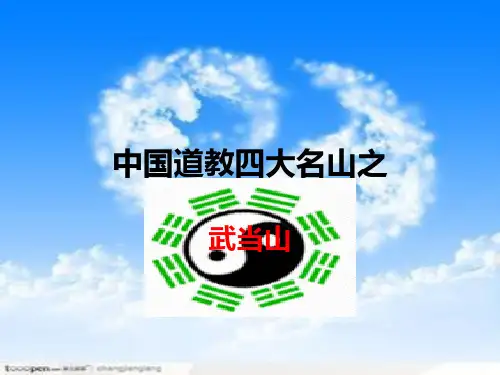
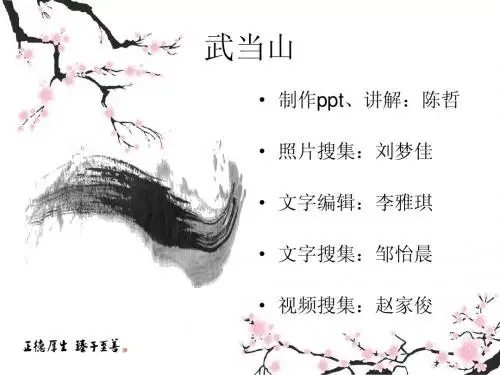
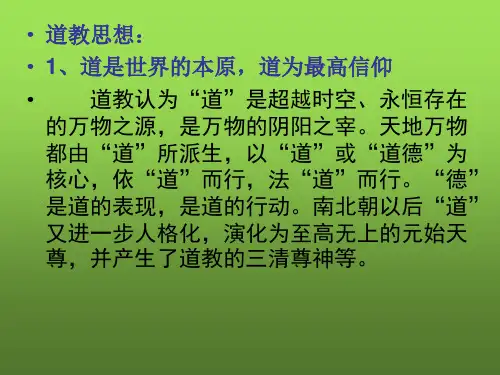
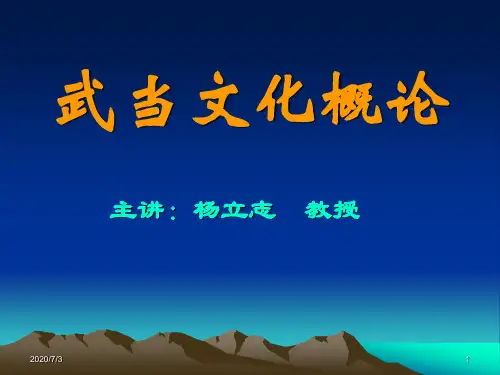
武当文化概论主讲:杨立志教授主讲人介绍—杨立志基本信息湖北丹江口人,历史学教授社会任职郧阳师范高等专科学校校长湖北省武当文化研究会会长华中师范大学历史文化学院硕士生导师个人荣誉十堰市首届有突出贡献专家湖北省新世纪高层次人才工程人选省级跨世纪学科带头人(1998年)省级优势学科“武当文化研究”学科带头人学术研究方向中国古代史,道教学,武当文化主要科研成果《武当道教史略》《道教与长江文化》等武当文化概论•第五章武当道教斋醮科仪与音乐艺术•第六章武当武术文化概述•第七章武当山进香民俗•第八章武当山道教文学与山水文学第五章武当道教斋醮科仪与音乐艺术➢第一节武当道教斋醮科仪的历史沿革和宗教功能➢第二节道教斋醮科仪的格式及宗教功能➢第三节武当道教斋醮科仪和音乐艺术第一节武当道教斋醮科仪的历史沿革•斋醮科仪,是道教独具特色的宗教祭祀仪式,是道教文化的重要内容。
按照宗教学理论,宗教活动是宗教的四大要素之一,宗教活动的核心是祭祀。
宗教祭祀是人与神沟通的重要方式,是向神灵的祝祷和祈求,宗教祭祀的本质是神灵信仰。
英国人类学家弗雷泽认为,宗教包含信仰理论和实践行动两大部分。
一、唐宋元武当斋醮活动和科仪经书•唐代以前武当山的道教斋醮活动情况,文献记载很少。
•北宋初期,道教真武真君信仰盛行。
北宋时醮祭真武神已是较为流行的道教信仰民俗。
•唐宋之际武当山地区的道教斋醮活动有所发展。
•南宋官方民间均崇奉北极真武佑圣真君。
•宋代流行的北极有关真武的斋醮科仪典籍有《真武灵应护世消灾灭罪宝忏》一卷、《北极真武普慈度世法忏》十卷、《北极真武佑圣真君礼文》一卷和《真武灵应大醮仪》六卷,这些经典比较全面地反映了宋代有关真武神斋醮科仪的情况。
二、元代武当道教斋醮科仪的发展•元代皇帝从太祖成吉思汗开始就对道教有一定的信仰。
元宪宗、世祖、成宗直到元顺帝均对道教神仙信仰有兴趣,尤其重视斋醮科仪。
•元皇室奉祀真武神,扶持武当道教,是从元世祖忽必烈开始的。
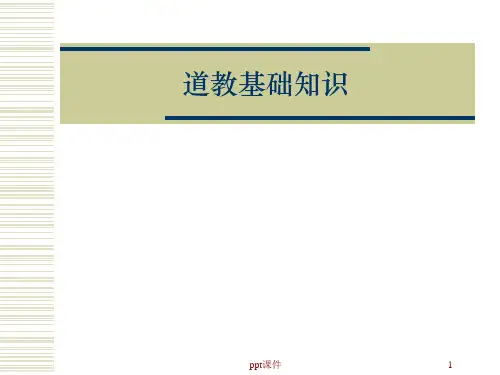
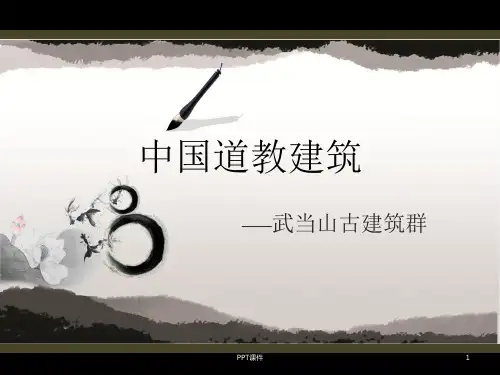
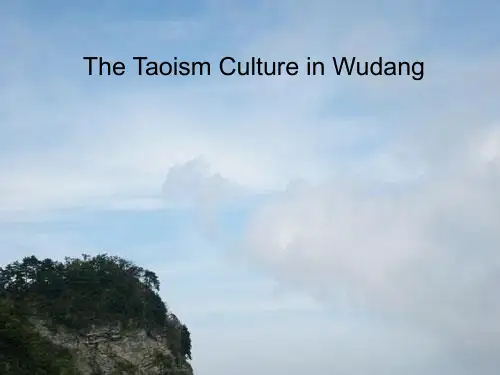
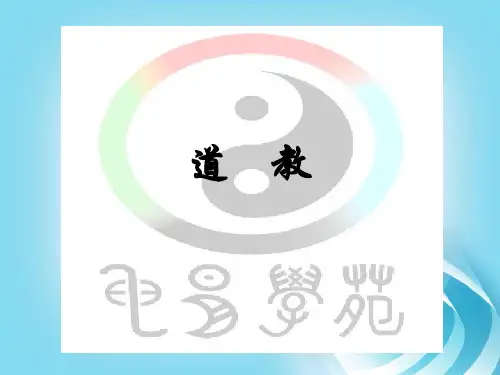

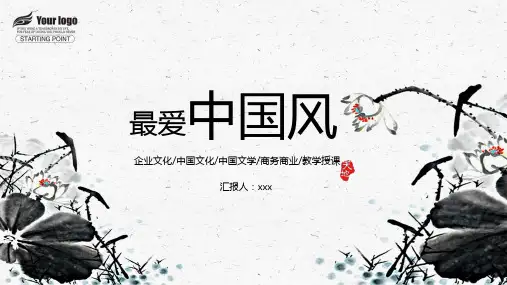
文化语言学下武当山道教文化图式探析一、引言武当山是中国较为著名的道教名山,位于湖北省十堰市丹江口市境内。
其道教文化源远流长,蕴含着丰富的宗教文化内涵。
本文从文化语言学的角度出发,对武当山道教文化进行图式探析,以深入了解其文化特征与内涵。
二、文化语言学视角下的武当山道教文化1. 文化语言学的概念文化语言学是指通过语言学来探讨文化现象,研究语言与文化之间的相互关系。
在文化语言学的视角下,我们可以通过语言的文字、词汇、语法等方面来了解一个文化的特征与内涵,以及文化的象征意义和价值体系。
2. 武当山道教文化的特征武当山是中国道教的重要发祥地之一,自古就有“武当天下第一山”之称。
在武当山,道教文化的体现主要集中在建筑、雕塑、绘画、音乐和文字等方面。
这些文化形式既是对道教教义的阐述,也是对道教观念和情感的表达,具有鲜明的宗教特征和文化内涵。
3. 武当山道教文化的图式在文化语言学的视角下,武当山道教文化可以被看作是一种图式,通过语言的符号、表征和符号的组合来构建出对道教文化特征和内涵的表现和传达。
这些图式不仅具有文化特有的象征意义,还承载了人们对道教信仰和情感的表达和追求。
三、武当山道教文化的图式探析1. 建筑图式武当山的建筑是道教文化的重要载体,这些建筑不仅是对道教教义的呈现,也是对道教观念和信仰的体现。
武当山的道观建筑最具代表性,如紫霄宫、太和宫、紫霄酒店等,这些建筑既展现了道教文化的神秘与庄严,又蕴含了道教理念的精髓和核心价值。
2. 雕塑图式武当山的雕塑作品是道教文化的另一个重要形式,这些雕塑以宗教人物、神祇和神话传说为素材,通过石刻、石雕、雕塑等形式来展现道教文化的精髓和主题。
比如在武当山的风景区中可以看到关羽石像、玉皇大帝石像等雕塑作品,它们既是对道教信仰的具象化表达,也是对道教文化的图式化呈现。
4. 音乐图式武当山的音乐作品是道教文化的另一种具体体现,这些音乐作品以武当山特有的音韵和节奏为特色,通过武当山的古乐、道教音乐等形式来传达道教文化的情感和内涵。
The Taoism culture in Wudang一、Introduction of mountain wudangWudang Mountain, named Taihe Mountain in ancient times, is located between Danjiangkou reservoir (水库)and the forest region of Shennongjia Nature Reserve in Shiyan city in the northwest part of Hubei Province. Stretching for a distance of over 400 kilometers, it offers marvelous views on its 72 soaring peaks, especially Tianzhu Peak with an altitude of l,612 meters above sea level. Wudang Mountain, for many centuries, has been chosen by Taoists as the place close to the fairyland after they pass away. Large Taoism architecture can be seen everywhere on the mountain. Legend has it that the God of the Northern Sky ascended heaven after he attained the highest state of spiritual enlightenment here. Since Taoism was born in Eastern Han Dynasty (25 A.D.- 220A.D.) , all previous monarchs(历代帝王)held ceremonies to seal the mountain pass, which caused a rapid rise in its fame, even more famous than the Five Sacred Mountains during the reign of Mingchengzu. It was the great master Zhang Sanfeng who made Wudang Mountain world-famous by establishing the Wudang Sect, sharing equal reputation with the Shaolin Sect in Songshan.The mountain was also reputed as the First Mountain under Heaven by Mi Fu, a master painter in Northern Song Dynasty.二、The history of wudang Taoism cultureAs early as the Eastern Han Dynasty (25–220 AD), the mountain attracted the Emperor's attention. During the Tang Dynasty (618–907), the first site of worship—the Five Dragon Temple—was constructed. The monasteries(修道院)were emptied, damaged and then neglected during and after the Cultural Revolution of 1966–1976, but the Wudang mountains have lately become increasingly popular with tourists from elsewhere in China and abroad due to their scenic location and historical interest. The monasteries and buildings were made a UNESCO World Heritage Site (世界文化遗产)in 1994. The palaces and temples in Wudang, which was built as an organized complex during the Ming Dynasty (14th–17th centuries), contains Taoist buildings from as early as the 7th century. It represents the highest standards of Chinese art and architecture over a period of nearly 1,000 years. Noted temples include the Golden Hall, Nanyan Temple and the Purple Cloud Temple.(一)From pre-Qin to western Han dynastyThis period can be seen as a preparation phase for thedevelopment of Wudang Taoism culture. In The spring and Autumn period ,Yin Xi,who was the first person to practice in Wudang mountain, spreading of Taoism historical figures.(二)From eastern Han to sui and tang dynasty From Eastern Han dynasty to the Sui and Tang dynasties, with the development of Taoism,Wudang was associated with Taoism culture gradually,This period can be seen as a Beginning of Wudang Taoism culture.In the late Eastern Han dynasty, Taoism was born .Then Wudang mountain gradually become the activity center of Central Taoism. From han dynasty to the northern and Southern dynasties,due to social unrest,hundreds of gentry classes give up there position,or leaved there hometown to Wudang mountain.For example, in the Jin dynasty, Xieyun and Xu Ziping give up there position in imperial Court.Besides, in the northern and Southern dynasties, Liuqiu also give up his position, and so on.They come to Wudang mountain to learn the Taoism culture,in another aspect, they improve the development of Taoism culture.In Sui and Tang dynasty,Wudang receive the Emperor's attention ,which promotes the development of WudangTaoism.As is known to everyone, in Tang dynasy, the emperors belive that Laozi,who has a high status in Taoism ,was their ancestor.So,they pay more attention on the Taoism.During this period Wudang's position has improved.(三)Song and Yuan DynastyThis phase ,Wudang Taoism form a system.The worship of Zhenwu was looked as the main features of Wudang Taoism.This period can be seen as a officially formation of Wudang Taoism culture.According to historical records, the two generation of song, yuan, Wudang Mountains has formed a considerable scale of Taoist groups. The early Yuan Dynasty, Zhang Shouqing disciples four thousand in the Wudang .At that time ,Wudang Taoism construction has made great achievements Unfortunately, some of the Taoist buildings were destroyed by the war war.(四)Ming and Qing DynastyDuring the Ming and Qing Dynasties, the emperors pay more attention on the Taoism than any other dynasty.This period was the peak period of Wudang Taoism culture development. During this period, a large number of buildings were constructedin Wudang Mountains. In the Jiajing thirty-one years (AD 1552) "Zhi Shi Xuan Yue" memorial archway was built, Wudang Mountains finally formed large scale with eight palace and two temples as the main body , as we can see tody . Now the ancient building in Wudang Mountains including Taihe palace, Nanyan palace, Zixiao palace, Yuzhen palace,Yuxu gong, and five dragon gong , as well as various temples temple, a total of more than 200. Construction area of 50000 square meters, covering a total area of more than 100 square meters.Yongle Emperor claimed the Zhenwu bless him and his father to Conquer the World,To repay the grace of God, he built 33 temples On the basis of the Yuan Dynasty in the Yongle ten years (1412). Following Yongle emperor, other emperors of the Ming Dynasty, aristocrat(贵族), local officials believers expanded the construction and rebuilt the temples. To rule the Wudang temple directly, Ming Dynasty emperors, all sent Captain ,who was directly responsible for the Royal family ,to manage everything of Wudang Mountains. In Jiajing (1522 - 1566), every temple of the mountains had at least three or four hundred people, the whole mountain more than ten thousand people,they are officer, Taoist, army, artisans and others.三、The Accomplishment of Wudang Taoism culture(一)Taoism architectural cultureWudang Taoism architectural culture includes the origin and scale of the largest Taoist architectural complex(建筑群).the macro(宏观)design idea of ancient architectural complex . the immortal thoughts and geomantic omen which are reflected through palace Gongguan and other temple. architecture style and aesthetic value of the existing temple. The concept to make the temple building harmonious with the natural environment. Temple architecture and religious activities, the people's evaluation,and so on.(二)Wudang Taoism props and cultural relicsWudang Taoism props and cultural relics :The fairy statues with a strong color of mount wudang Taoism , Faqi , inscriptions (碑铭),mural (壁画),couplet(楹联),plaques(匾额),which have the outstanding technical standards and beautiful artistic characteristics ,are precious cultural heritage of the Chinese nation.They condense Chinese social cultural tradition.(三)Wudang martial arts cultureWudang martial arts culture:Wudang boxing was deeply Influenced by Taoist ideas , its The basic theory , including the philosophy of Taoism, inner alchemy theory(内丹理论), self-cultivation, moral cultivation;Zhang Sanfeng and Tai Chi.(四)Wudang Taoism beliefWudang Taoism belief: since the Song Dynasty, people around the country has the customs to Worship mountains. They form organization,research society,and a series of folk festival which is is closely related tot he Taoist belief .like the Spring Festival, March three, September nine .Besides,The unique literature, The wonderful music ,wudang tea and so on ,Wudang Taoism culture are more than these,in one word, Wudang Taoism culture is extensive and profound.四、ConclusionAs the cradle of the Taoist culture, the Wudang Mountain was inscribed on the list of World Cultural Heritages in 1994. The scenery of the mountain attracts tens of thousands of visitors every year. Over 4 million tourists from at home and abroad are expected to visit the site this year.。